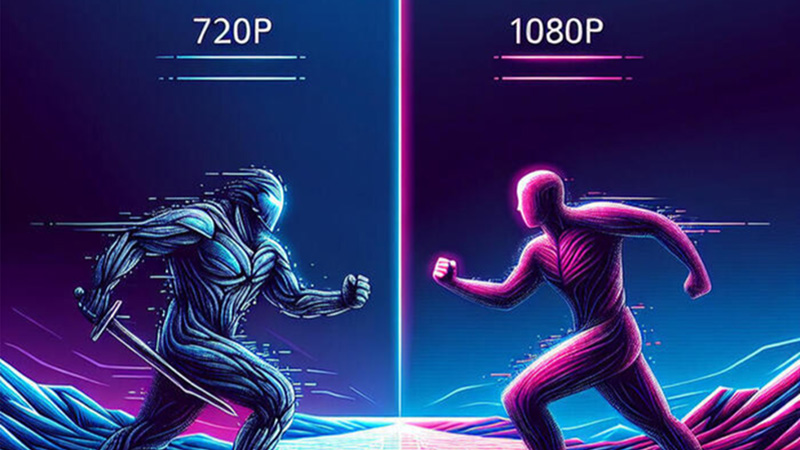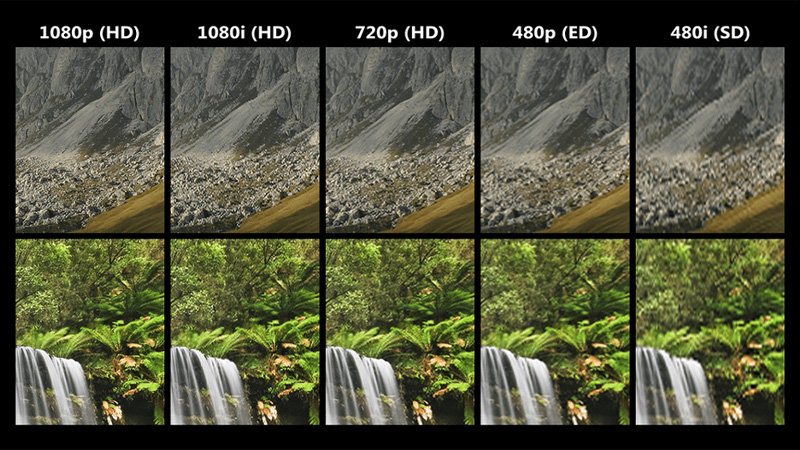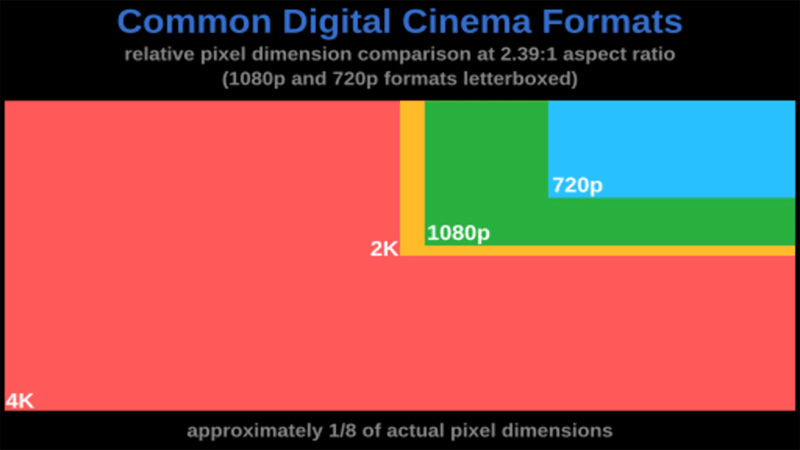
720P Vs 1080P in 2024: Differences & Comparison
The greater the clarity of the resolution, the better. However, most of us forget that video makers must consider other things. The nature of the event being filmed, the available technology employed, and the platform to broadcast will eventually factor into the equation.
In this context, we must evaluate two of the most used display resolutions available: 720P and 1080P. What are they, strictly speaking? How can the 720P and 1080P enhance your viewing experience in any platform or medium?
Most of all, which is better suited for the needs of viewers and video creators? Is one preferable to another? Those are things worth discussing. We will evaluate the strengths and weaknesses of each to better guide you in employing the appropriate display resolution.
1. 720P and 1080: Display Resolutions
720P and 1080P are types of display resolutions. Terms may vary depending on the medium or platform one uses: TV resolution, mobile screen resolution, etc., but they all refer to the same thing.
720P and 1080P specifically refer to the measurement or number of pixels in each screen image in each time. The actual measurement of 720P is 1280×720, while 1080P has 1920×1080. Multiply them, and you have the actual number of pixels: 921,600 for 720P and 2,073,600 for 1080P.
“P, meanwhile, refers to “progressive scan.” Progressive scanning is how a particular medium displays a video, and the number indicated (480P, 720P, 1080P) refers to the number of lines in a particular frame.
Before the advent of 4K, 720P and 1080P were undisputed kings of high definition. As we will see later, they are still in high demand today. The primary reason is that higher pixels mean better quality and clarity, but this has its drawbacks.
Though some video creators opt for the best, having higher pixels sometimes does not do the trick. There are many things to consider when creating the best quality video, and though clarity and quality are usually the ultimate measures, that is not always the case.

2. 720P and 1080P: Comprehensive Comparison
Aside from earlier versions of high-definition display resolutions, what other aspects do they compare?
1). Cutting Edge: Similarities of 720P and 1090P
- Excellent Quality and Clarity
There were earlier versions of high-definition display resolutions, but 720P and 1080P were great leaps from previous versions. They provide consumers with a viewing experience never before seen in history, at least before the advent of 4K and Ultra-High Definition.
- At Par with Modern Technology
Part of the reason is that as televisions, PC monitors, and gadgets became larger, you needed a display resolution that was a perfect match for the technology. 720P and 1080P are the perfect technological innovations for such apparatus.
720P and 1080P are similar in the general sense of giving viewers better-quality videos. They are superior in clarity and adapted to most technologies. Vital differences will become apparent once we delve into details.
2). The Devil in the Details: Differences Between 720P and 1080P
- Differences in Pixels
Higher pixels mean better display resolution, and 1080P, which is higher than the other, provides a clearer image and resolution. With movies, documentaries, and series in streaming platforms requiring higher and higher resolution for optimum viewing experience, having 1080P over 720P may spell the difference.
First, we have to discuss why higher pixels mean a clearer image. As the medium becomes bigger in size, you need more pixels to maintain consistency in clarity, sharpness, color, and contrast.
In the early days before the advent of giant televisions, 720P would have been enough. But with televisions and PC monitors evolving, you need a higher display resolution to keep up to maintain optimum viewing experience and maximum viewing pleasure.
- Different Medium
Following the discussion above, to optimize the viewing experience in 720P, you need the appropriate size of a medium. 720P is still very much around, and it is the display resolution of choice for most gadgets and smartphones.
1080P is appropriate for larger ones, such as oversized televisions and monitors that have become fashionable for over a decade or two. Since more extensive television sets try to recapture the cinematic experience, they also need to reproduce the “actual feel and texture of the images as accurately as possible.
- Efficiency
The higher the display resolution, the bigger the bandwidth and faster internet speed you need. Since 1080P is higher, it needs more bandwidth and faster internet speed. For this reason, it will be best for a mobile person who does not have a stable internet connection to watch a film on 720P than on 1080P.
Since it is smaller, 720P entails many other advantages. It is smaller and easier to download and stream. Those who are watching live events find it more efficient to broadcast on 720P. Not only are they more efficient, but they can reach a wider audience because you can have better quality streaming, whatever the medium.

3. 720P vs 1080P: Which is Better?
The commonplace wisdom is that higher display resolution results in better video quality and viewing experience. However, utility and application also matter, not only for consumers and viewers but also for creators. The creators need to balance better quality, and the audience needs to gain traction.
Hence, the assessment will mainly include everything that 720P and 1080P offer and who benefits from using or applying them.
1). Why Choose 720P
Here are some reasons why choosing 720P, whether as a viewer or creator, will make more sense.
- For persons always on the go
If you are always outside, moving from place to place, and taking commutes like trains, buses, etc., using 720P is better. It is more economical regarding bandwidth and more efficient in speed.
And even if you have the most excellent bandwidth and the fastest net speed while in transit, using 1080P on your smartphone will not make any difference, quality-wise.
- Streaming small events
If you want to do a livestream for small events, like birthday parties, baptisms, or small weddings, 720P will make more sense if you do not need sharper focus or higher precision when covering and filming details.
That is why most social media platforms employ 720P. It can give you the best of both worlds: You need not sacrifice clarity and smoothness as you stream live. Most streamers are only in small rooms or places and focus only on their faces and bodies.
If you stream or watch streamers, having 1080P for that purpose does not make sense. Better quality and sharper focus will give you little satisfaction regarding your viewing experience.
- Suitable for old movies
Many Hollywood classics have been “upscaled”, that is, technologically altered so that they are viewable in high definition, 1080P included. But if you are a fan of cult classics and all those movies that are not digitally restored, watching them in 720P might be the best option, for no version of 1080P probably exists.

2). Why Choose 1080P
Here are some reasons why choosing 720P, whether as a viewer or creator, will make more sense.
- For persons who watch films at home
You have a very fast internet connection and a very large home theater, and you watch films together with your family and friends while having snacks. You are more into films than live streaming and want every detail on your screen to be clear, sharp, and of the best quality.
- Best for live streaming of larger significant events
Big professional events need more detail and sharper focus. The idea is that you broadcast for a captive audience who will spend more on bandwidth and internet speed. It is best to choose 1080P, for it can give you the best of everything when it comes to coverage, quality, and clarity.
- You’re a gamer
Game consoles have come a long way, and vast improvements in specs, speed, and smoothness necessitate a display resolution that can give you a more immersive gaming experience.
If you are playing older consoles, 720P may be enough. But for newer ones, it will be best to go with 1080P. You probably play it on a bigger television, and you need to see the finer aspects of the game, so you need a higher display resolution.
4. What Are the Impacts of 720P and 1080P on LED Screens?
For LED screens that play videos, it is obvious that the 720P video effect cannot satisfy the current audience because the pixels are not high, and the image is not clear. It is acceptable if it is just a simple display of pictures or text.
When the pixels reach 1920*1080 or higher 4k, the effect of LED screen playback is realistic, high-definition, and more effective in restoring the show scene; especially for stage background screens (rental RX series), we generally recommend at least a 1080P pixel standard.

- Front Service Magnetic LED Module
- Can Removable Back Power Supply Box
- Optional Curved Lock and Bevel Cabinet
- Optional Cabinet Size and Handle Color
- Have 3 Years Warranty and 5% Spare Parts
5. Final Thoughts
We want the best experience, whether as viewers or content creators. All things being equal, having a higher resolution can give you the optimum viewing experience for enhanced aesthetic pleasure. But as we pointed out, there are some things to consider.
The 720P and 1080P display resolutions have strengths, but they also have cons. Before you choose 720P or 1080P, consider what you want and need.
Now, in 2024, there are many other options besides the two. Still, they remain at the top precisely because they have distinct advantages that are unavailable in any other display resolution. We have discussed why you need to choose 720P over 1080P and vice versa.
Just like in any other situation, what is best is what suits you and what you can enjoy. That should be your primary consideration.